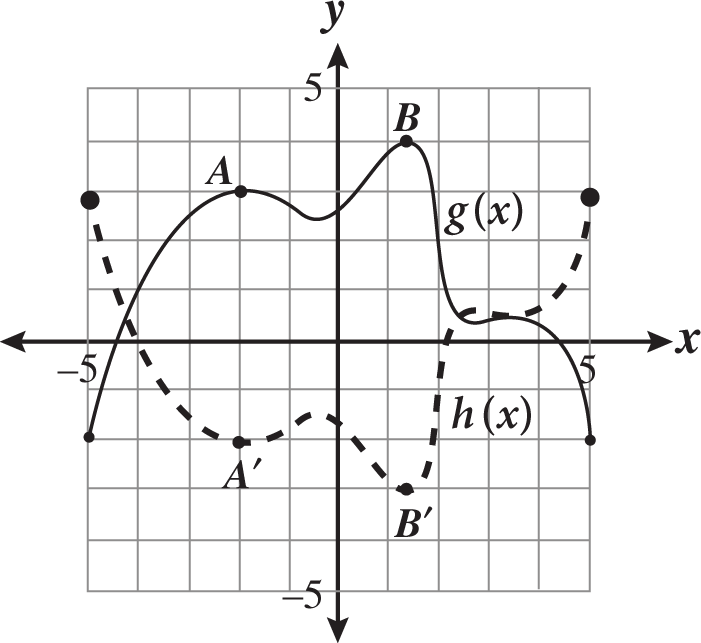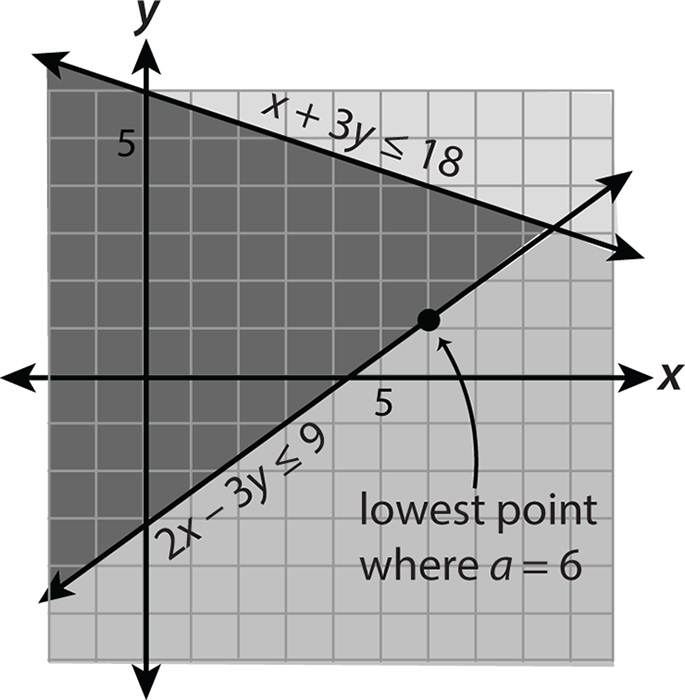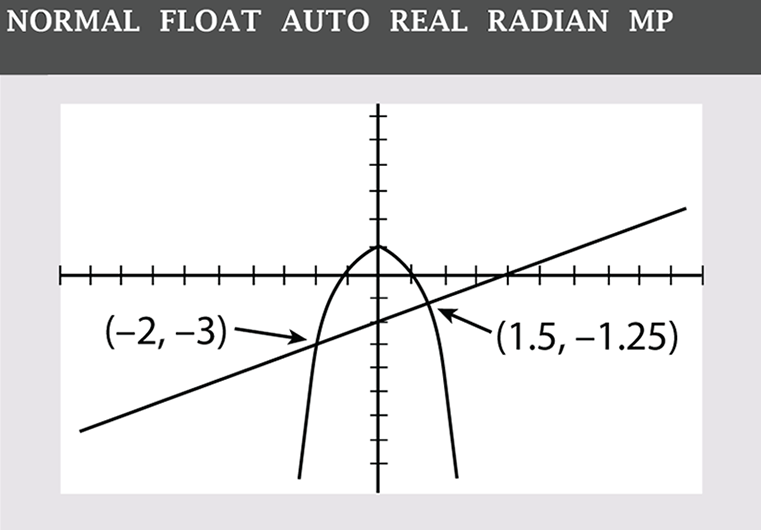Answers and Explanations
Reading Test
Anna Karenina
-
Suggested passage map notes:
- ¶1: Levin goes to skating rink to find Kitty
- ¶2: description of day, people
- ¶3: walks to skating area; nervous, sees K skating
- ¶4: knows her right away, still nervous
- ¶5: lots of happy people skating
- ¶6: cousin greets him
-
A/Difficulty: Easy
Category: Detail
Getting to the Answer: Make sure to read the passage closely so events are clearly understood. The first paragraph explicitly states how Levin knew that Kitty was there: he saw her family’s carriage. Choice (A) matches the information stated in the passage.
-
B/Difficulty: Medium
Category: Vocab-in-Context
Getting to the Answer: Use context clues to help you distinguish the shades of meaning each word has. Two of the answer choices have a somewhat negative connotation. The author is not describing the scene in a negative way. In this passage, the word “swarmed” means “gathered.” Therefore, (B) is the correct answer. The other words’ connotations do not fit with the context of the sentence.
-
C/Difficulty: Hard
Category: Inference
Getting to the Answer: Look for clues in the text that suggest what Levin is like. Emotionally charged phrases, such as “the rapture and the terror that seized on his heart” (lines 31–32), help reveal Levin’s personality. Choice (C) reflects the depiction of Levin as a passionate person.
-
C/Difficulty: Hard
Category: Command of Evidence
Getting to the Answer: Eliminate answer choices that don’t include a description of Levin. Because the excerpt focuses on Levin’s feelings toward Kitty, evidence of the kind of person he is will probably reflect this. Choice (C) provides the best evidence.
-
A/Difficulty: Medium
Category: Global
Getting to the Answer: The central theme of a passage is the insight about life that the author is trying to get across to the reader. Eliminate any themes that are not revealed by the experiences of Levin. Though you may personally agree with more than one of the themes presented, (A) is the only answer choice that is supported by details in the passage. Levin’s feelings and actions support this theme.
-
C/Difficulty: Medium
Category: Inference
Getting to the Answer: Examine the passage to see what other characters do in response to Levin. The other skaters go about their business. Most take little notice of Levin. Therefore, (C) is the correct answer.
-
D/Difficulty: Medium
Category: Command of Evidence
Getting to the Answer: Reread each quote in the context of the passage. This will help you decide the correct answer. Of all the answer choices, Nikolay’s way of greeting Levin is the strongest evidence that people think Levin seems normal. Choice (D) is the correct answer.
-
A/Difficulty: Medium
Category: Vocab-in-Context
Getting to the Answer: The context of the passage can help reveal the meaning of the word. Insert each choice in the sentence to see which one makes the most sense. Levin speaks directly to his heart, asking it to behave. Choice (A), “begged,” comes closest to meaning the same thing as “conjured” in this context.
-
D/Difficulty: Medium
Category: Function
Getting to the Answer: Think about the entire scene described in the passage and decide why the author chose to describe Levin’s heart as “throbbing.” Choice (D) is the correct answer. The author chose this word to capture Levin’s agitated state.
-
A/Difficulty: Hard
Category: Inference
Getting to the Answer: Eliminate answer choices that are clearly not representative of the author’s feelings or attitude about Levin. The author presents Levin’s situation as one that is painful. The passage’s tone suggests that Levin is worthy of the reader’s empathy. Choice (A) fits this tone.
-
Franklin Delano Roosevelt Speech
Suggested passage map notes:
- ¶1: U.S. devoted to democracy
- ¶2: must think about soc. & eco. problems which → soc. revol.
- ¶3: list of basics of dem.
- ¶4: must maintain basics
- ¶5: list of what should be improved
- ¶6: Americans will personally sacrifice for them
- ¶7: explain tax changes
- ¶8: people will be ok with them
- ¶9: four essential human freedoms
- ¶10: freedom of speech and expression
- ¶11: freedom of religion
- ¶12: freedom from want
- ¶13: freedom from fear
- ¶14: are attainable now; against new order of tyranny
- ¶15: moral order
- ¶16: change can made done peacefully
- ¶17: U.S. supports human rights everywhere and will win
-
D/Difficulty: Hard
Category: Global
Getting to the Answer: The introduction to the passage states that President Roosevelt intends to preserve and spread democracy. Choice (D) makes clear that the president wants to promote human rights, which can be achieved by spreading “American ideals around the world.”
-
D/Difficulty: Hard
Category: Command of Evidence
Getting to the Answer: Be careful of choices that do not provide direct evidence to support the president’s purpose. The correct answer will relate specifically to the stated purpose, or intent, of the passage. President Roosevelt makes clear that his intention is to provide support for global efforts to end tyranny and spread democracy and to garner the support of the American people for these goals. In the previous question, his stated purpose is to “make its people conscious of their individual stake in the preservation of democratic life in America” (lines 3–4). Only (D) provides direct evidence for the previous question.
-
D/Difficulty: Easy
Category: Vocab-in-Context
Getting to the Answer: All answer choices are alternate meanings of the word “sacrifice.” The correct answer will relate directly to the context of the passage. Despite the fact that Roosevelt gave the speech on the eve of America’s involvement in World War II, neither (B) nor (C) is the meaning he’s after. Choice (D), “surrender of interests to a greater good,” is the correct answer.
-
B/Difficulty: Hard
Category: Inference
Getting to the Answer: Keep in mind that you’re looking for a relationship that is suggested, not stated. To reach the correct answer, you must infer, or make a logical guess, based on information in the passage. The correct answer will provide support for the stated purpose of the passage while demonstrating a logical relationship. Choice (B) provides support for the stated goal of winning support among U.S. citizens for the spread of democracy abroad. It does so by suggesting that the security of U.S. democracy depends on the advancement of human rights and freedoms globally.
-
D/Difficulty: Medium
Category: Command of Evidence
Getting to the Answer: Avoid answers that provide evidence for incorrect answers to the previous question. The correct answer will use language reflective of the correct answer above to demonstrate a relationship. Principles and ideas such as democracy, freedom, and protection of human rights are used interchangeably throughout Roosevelt’s speech. The lines in (D) draw the connection between freedom at home and freedom everywhere.
-
C/Difficulty: Easy
Category: Vocab-in-Context
Getting to the Answer: Substitute each answer choice for the word in question and decide which one fits the context provided in the passage. In the context of the passage, (C) works best. It draws a distinction between individual citizens’ monetary interests, or their pocketbooks, and the cause of patriotism, or the greater good.
-
A/Difficulty: Medium
Category: Inference
Getting to the Answer: Keep in mind that the correct answer will relate directly to the meaning of the elements in the identified lines. President Roosevelt is arguing against those who would oppose the overarching goal of his speech, namely to garner support for the spread of democracy overseas. Choice (A) fits best; Roosevelt asserts that his goals are realistic and attainable, not just idealistic visions, as his opponents might claim.
-
D/Difficulty: Medium
Category: Command of Evidence
Getting to the Answer: Be wary of answers like (A) and (B) that seem to offer specific advice or state specific goals relevant to the purpose of the passage without suggesting how those goals might be achieved. The correct answer will offer a tool, a condition, or another asset for achieving the passage’s claim—in this case, the spread of democracy. The previous question identifies that President Roosevelt considers the spread of global democracy achievable. This question asks you to identify how the president envisions achieving that purpose. Choice (D) matches the intent. In this line, President Roosevelt identifies “our unity of purpose” as an asset that will help achieve his goal.
-
C/Difficulty: Hard
Category: Inference
Getting to the Answer: Be careful of answers that cite other policies that the president might support that are not related to the lines quoted. The correct answer will relate directly to the specific lines in question. In this speech, Roosevelt identifies four freedoms that he views the United States as obligated to defend. The freedom from want signifies a commitment to helping struggling populations at home and abroad. Choice (C) fits. The president urges economic understandings among nations to help those in need.
-
C/Difficulty: Medium
Category: Function
Getting to the Answer: Be careful of answers like (A) that offer other viable uses of rhetoric within the larger passage. The correct answer will relate specifically to the text cited in the question. Roosevelt suggests that the preservation of American freedoms cannot exist without the preservation of human rights on a global scale. To cement this connection, he contrasts democratic movements with tyrannical movements occurring in the world. Choice (C) is the correct answer. President Roosevelt references “the so-called new order of tyranny” in order to show what might happen should the United States and the American people not support other nations in their fight against such tyranny.
-
Women’s Suffrage
Suggested passage map notes:
- ¶1: changes in Am. voting process
- ¶2: women’s voting history; Seneca Falls declaration
- ¶3: 1878 – amendment proposed, federal gov’t not ready
- ¶4: women voting in New Zealand, Australia, United Kingdom
- ¶5: WWI → female activism; 19th Amendment passed in 1919, ratified 1920
- ¶6: elections still not equal b/c Af. Americans often disenfranchised; 1965 Voting Rights Act → voting equality for all
-
C/Difficulty: Medium
Category: Inference
Getting to the Answer: Keep in mind that the “stance” of an author refers to his or her perspective or attitude toward the topic. The passage is written by a scholar or a historian who is looking back on the events that led to the adoption of the Nineteenth Amendment. It is not written by a primary source, such as a legislator or an advocate in the midst of the movement’s events. For this reason, (C) is the correct answer. The author of the passage is clearly a scholar evaluating not just the motivation of women’s suffrage leaders but the key events and impact of the movement as a whole.
-
B/Difficulty: Hard
Category: Inference
Getting to the Answer: Avoid answers like (A) that refer to related issues not relevant to the passage’s purpose and answers like (D) that go too far. The correct answer will identify a claim that is supported by the quotation. In the quote, the author notes that election laws following passage of the Nineteenth Amendment did not secure equal voting rights for all. From this statement, it becomes clear that other groups of people still needed support for their voting rights. Answer (B) is correct.
-
D/Difficulty: Medium
Category: Command of Evidence
Getting to the Answer: Reread the line quoted in the previous question and notice that it occurs in the passage after ratification of the Nineteenth Amendment. Therefore, the evidence you’re looking for will refer to an event that came later. The author suggests that the Nineteenth Amendment did not win equal voting rights for all citizens but that it did serve as an important step on the way to free and fair elections. Choice (D) demonstrates that a later event expanded voting rights further, to citizens regardless not only of gender but also of race.
-
C/Difficulty: Easy
Category: Vocab-in-Context
Getting to the Answer: Consider the events that are being described in the paragraph in which the word appears. This will help you choose the best answer. It’s clear in this paragraph that the women’s suffrage movement was gaining momentum at this time. Events and tactics excited those who supported the movement and attracted more supporters. Therefore, (C) reflects the correct meaning of “galvanized.”
-
A/Difficulty: Hard
Category: Function
Getting to the Answer: Carefully review the paragraph in which the line appears before choosing the best answer. Choice (A) demonstrates the connection between successfully changing one element (people’s minds) in order to change the other (laws).
-
A/Difficulty: Hard
Category: Inference
Getting to the Answer: Be wary of answers like (D) that go too far in asserting unsubstantiated causal relationships. The correct answer will reference an idea or a relationship that is supported by the content of the passage. Choice (A) expresses the idea implicit in the passage that the American government responds, sometimes slowly, to the changing needs and sentiments of the American people.
-
D/Difficulty: Hard
Category: Command of Evidence
Getting to the Answer: Watch for answers like (A) and (C) that cite specific changes or examples but do not provide direct support. The correct answer to the previous question states the idea implicit in the passage that the government responds and adapts to changes in U.S. society. This suggests a gradual change. Choice (D) demonstrates the idea that both society and the government have changed over time as the civil rights movement of the late twentieth century overcame social and legal inequalities inherited from earlier in the nation’s history.
-
C/Difficulty: Medium
Category: Inference
Getting to the Answer: Be careful of answers that aren’t backed by sufficient evidence in the graphic. The graphic shows proof that women’s suffrage unfolded through a series of events over a long period of time. Choice (C) is the correct answer.
-
C/Difficulty: Medium
Category: Vocab-in-Context
Getting to the Answer: Read the sentence in which the word appears. The correct answer should be interchangeable with the word. The passage states in lines 60–62 that “Posters . . . called into question the authenticity of a free country with unjust laws.” Choice (C) is the correct answer as “legitimacy” refers to something that is in accordance with established principles.
-
B/Difficulty: Medium
Category: Inference
Getting to the Answer: Be cautious about answers that present accurate facts but that do not directly relate to the content of the question. Choice (B) is the correct answer. Wilson’s framing of the conflict abroad as a fight for democracy and freedom helped women suffragists draw attention to the fact that the U.S. government was fighting for justice abroad while denying justice at home.
-
D/Difficulty: Medium
Category: Inference
Getting to the Answer: A question like this is asking you to compare information provided in the graphic with information provided in the passage text. Consider each answer choice as you make your comparison. Choice (D) is the correct answer. Both the graphic and the passage indicate that women’s suffrage gained early victories in several states quite a few years before becoming law at the federal level through passage of the Nineteenth Amendment.
-
Paired Passages—Radioisotopes
Suggested passage map notes:
Passage 1
- ¶1: (central idea): use atoms to date things; isotopes def. & exs.
- ¶2: isotopes unstable; measure C-14
- ¶3: C-14 decay = predictable
- ¶4: C-14 dating; materials; timeline based on layers
Passage 2
- ¶1: def. radioactive; why dangerous; danger = radiation rate
- ¶2: half-life def. = decay rate; exs.
- ¶3: long half-life = long problem
-
C/Difficulty: Hard
Category: Inference
Getting to the Answer: Use your passage map to locate the paragraph that explains carbon-14 dating. This paragraph will contain the description of what materials can be dated using this method. In paragraph 4, the author states that carbon-14 dating can be used on materials made by a living organism. An arrowhead made from a bone is constructed of such material, choice (C).
-
D/Difficulty: Hard
Category: Command of Evidence
Getting to the Answer: Locate each of the answer choices in the passage. The correct answer should provide direct support for the answer to the previous question: the bone arrowhead can be dated using carbon-14 dating. In paragraph 4, the author describes the process for carbon-14 dating. Choice (D) is correct because this sentence provides a direct description of the materials that can be dated using carbon-14 dating.
-
B/Difficulty: Medium
Category: Vocab-in-Context
Getting to the Answer: Pretend that the word “decay” is a blank. Reread around the cited word to predict a word that could substitute for “decay” in context. The previous paragraph discusses how scientists measure the rate of emission to calculate the amount of carbon-14 in a sample. “Emission” means release; therefore, the amount of carbon-14 is becoming smaller if the atoms are releasing it. In this sentence, therefore, predict “decay” means to decrease, which matches “deteriorate,” choice (B).
-
C/Difficulty: Easy
Category: Detail
Getting to the Answer: Look at your notes for paragraph 3. Summarize the ratio of carbon-12 to carbon-14 in living tissue in your own words. Look for the answer choice that most closely matches your prediction. In paragraph 3, the author explains that the ratio of carbon-12 to carbon-14 for living things is the same as the ratio in the atmosphere: constant. Choice (C) is correct.
-
C/Difficulty: Medium
Category: Command of Evidence
Getting to the Answer: Review what part of the passage you used to predict an answer for the previous question: the ratio is constant for living things. Of the answer choices, only lines 26–29 explain the ratio of carbon-12 to carbon-14 in living things. Choice (C) is correct.
-
B/Difficulty: Medium
Category: Detail
Getting to the Answer: Read around the cited lines. The author directly states why a release of iodine-131 is not cause for long-term concern. In paragraph 3, the author explains that the initial release of radiation from an accident involving iodine-131 will be high, but the level of radiation will drop quickly (lines 71–72). Choice (B) is correct.
-
C/Difficulty: Medium
Category: Detail
Getting to the Answer: Use your passage map to find the information about why exposure to radiation is dangerous.
Getting to the Answer: In paragraph 1, lines 50–52, the author explains that radiation is harmful to living tissue because it can cause damage to the cells’ DNA, which matches choice (C).
-
A/Difficulty: Easy
Category: Vocab-in-Context
Getting to the Answer: Pretend that the word “original” is a blank. Reread around the cited word to predict a word that could substitute for “original” in context. The previous paragraph explains how scientists use “half-life” to determine how quickly material decays. If the material is decaying, then predict “original” refers to the first material. Choice (A) matches your prediction.
-
D/Difficulty: Medium
Category: Detail
Getting to the Answer: Review your notes for Passage 2. Try to put into your own words how scientists use half-life calculations of radioactive materials. Look for the answer that most closely matches your idea. In paragraph 1, the author explains that the level of danger posed by radiation released during a nuclear accident depends on how quickly radiation is released (lines 57–59). In paragraph 2, the author discusses how the half-life of radioactive material is used to determine how long a material will emit radiation. Paragraph 3 then explains how different half-lives translate into short-term or long-term radiation concerns. Choice (D) is correct because it most clearly paraphrases the information in the passage about how scientists use half-life calculations.
-
A/Difficulty: Hard
Category: Inference
Getting to the Answer: The central idea will be supported by all of the evidence presented in both passages. Review the central idea you identified for each passage in your passage maps. Passage 1 discusses the application of atomic and nuclear physics in archaeology, while Passage 2 details how scientists apply atomic and nuclear physics to studies of radioactivity in nuclear power plant accidents. Choice (A) is correct.
-
A/Difficulty: Hard
Category: Inference
Getting to the Answer: Analyze the graph to see that it describes the decay of carbon-14 over time. Think about how this data relates to the texts. The graph portrays the decay of carbon-14 as described in Passage 1. The definition of “half-life” is given in Passage 2. The half-life of a material is the amount of time it takes for half of that material to decay. The graph shows that about 50 percent of carbon-14 remains after 5,400 years. Choice (A) is correct.
-
Biomimicry Passage
Suggested passage map notes:
- ¶1: George de Mestral—invented velcro
- ¶2: biomimicry—study nature to improve people’s homes, cities, etc.
- ¶3: used in architecture
- ¶4: Michael Pawlyn—adapt principles behind natural shapes → innovative solutions
- ¶5: used in optics and robotics
- ¶6: some natural stuff not advanced but simple: abalone shell
- ¶7: nanoscale features; Andrew Parker—skin of thorny devil
- ¶8: can learn from animal features
- ¶9: improve energy efficiency
- ¶10: radical, optimistic field
-
A/Difficulty: Medium
Category: Global
Getting to the Answer: Look for the answer choice that describes an idea supported throughout the passage rather than a specific detail. The passage cites several examples of biomimicry, the study of how materials and systems found in nature can be replicated to benefit humans. Therefore, (A) is the best summary of the central idea of the passage.
-
B/Difficulty: Medium
Category: Command of Evidence
Getting to the Answer: Think back to why you chose your answer to the previous question. This will help you pick the correct quote as evidence. Choice (B) is the correct answer because it provides evidence for the central idea that the author presents about the field of biomimicry.
-
A/Difficulty: Hard
Category: Function
Getting to the Answer: Think about the primary purpose of the quote. Eliminate any answer choices that don’t support this purpose. The quote, which is from a book on architecture, explains why architects turn to biomimicry for solutions in their work. Choice (A) is the correct answer.
-
B/Difficulty: Medium
Category: Inference
Getting to the Answer: Reread the paragraph that the question is asking about. Look for specific details about the abalone shrimp shell and soft chalk. The passage clearly states that the abalone shrimp shell is harder than soft chalk because of the way the basic material composing each is arranged, so (B) is the correct answer.
-
D/Difficulty: Medium
Category: Function
Getting to the Answer: In order to understand why an author includes a quote from another person, examine the surrounding sentences. This often makes clear the author’s reason for including the quotation. The author includes the quote from Pawlyn to support and strengthen his or her own view that energy efficiency “has never been more important.” Therefore, (D) is the correct answer.
-
D/Difficulty: Easy
Category: Vocab-in-Context
Getting to the Answer: Replace the word in question with each of the answer choices. This will help you eliminate the ones that don’t make sense in the context. Choice (D), “concepts,” is the only answer choice that makes sense in this context because it reflects the foundational reasons behind the structures.
-
A/Difficulty: Medium
Category: Inference
Getting to the Answer: Keep in mind that you’re being asked to make an inference, a logical guess based on information in the passage. Therefore, the correct answer is not stated in the passage. The variety of examples of biomimicry mentioned in the passage make it reasonable to infer that more scientists will utilize solutions developed through biomimicry in the future. Choice (A) is the correct answer.
-
C/Difficulty: Medium
Category: Command of Evidence
Getting to the Answer: Reread each quotation in the context of the passage. Consider which one is the best evidence to support the inference made in the previous question. The examples cited in (C) provide strong evidence for the inference that more scientists will probably make use of biomimicry in years to come.
-
D/Difficulty: Medium
Category: Vocab-in-Context
Getting to the Answer: Eliminate answer choices that are synonyms for the word in question but do not work in the context of the sentence. Because biomimicry is such an innovative approach, it makes sense that the meaning of “radical” in this context is closest to (D), “revolutionary.”
-
C/Difficulty: Hard
Category: Inference
Getting to the Answer: Remember that a graphic might not refer to something explicitly stated in the passage. Instead, it often provides a visual example of how an important concept discussed in the passage works. The graphic and its caption help illustrate an example of biomimicry not mentioned in the passage: that of a solar power plant designed to mimic the arrangement of petals in a sunflower. This directs more energy toward the power plant’s central tower and improves the efficiency of the power plant. Choice (C) is the correct answer.
Writing and Language Test
The Age of the Librarian
-
C/Difficulty: Easy
Category: Agreement: Verbs
Getting to the Answer: Examine the verb tense in the rest of the sentence. This will help you find the correct answer. As written, the sentence switches verb tense mid-sentence. Other verbs in the sentence, “worked” and “was,” indicate that the events happened in the past. Choice (C) is the correct choice because it correctly uses the past tense of the target verb.
-
D/Difficulty: Medium
Category: Sentence Structure: The Basics
Getting to the Answer: Pay attention to the quotation marks. Reading through the sentence and the answer choices shows that two issues might need correcting. The sentence inside the quotation marks is a complete sentence. The correct answer needs to punctuate that sentence before closing the quote. Additionally, “however” is being used as a connector or transition word and needs to be followed by a comma after beginning the new sentence. Choice (D) appropriately uses a period prior to the end quotes and correctly inserts a comma after the transition word “However.”
-
B/Difficulty: Medium
Category: Development: Precision
Getting to the Answer: Watch out for choices that distort the tone of the passage. The passage suggests that people expected or anticipated that Harris would become a librarian. Evidence for this idea is found in the statement that she was “constantly told” that she “should be studying to be a librarian.” Harris was certainly aware that people anticipated this course of study for her, but the presence of the phrase “Little did she realize” tells you that she didn’t expect to become one. The correct choice is (B), “imminent,” meaning that becoming a librarian was about to occur despite her own expectations.
-
C/Difficulty: Hard
Category: Development: Precision
Getting to the Answer: Read the sentence carefully for context clues. Also, think about the tone of what is being described. This will help you choose the best answer. Given the phrasing of the sentence, the answer must be close in meaning to “excited,” which is used earlier in the sentence. Therefore, (C) is the correct answer.
-
A/Difficulty: Medium
Category: Sentence Structure: The Basics
Getting to the Answer: Determine whether a clause is dependent or independent to decide between a comma and a semicolon. Choice (A) is the correct answer. The sentence is correctly punctuated as written because it uses a comma at the end of the introductory dependent clause.
-
C/Difficulty: Medium
Category: Agreement: Modifiers
Getting to the Answer: Read the sentence carefully. The sentence sounds clunky and awkward. Look for an answer choice that makes the sentence clear and easy to understand. Notice that the word “asking” is part of a participial phrase that modifies “Miguel.” A participial phrase should be placed as close as possible to the noun it modifies. When a participial phrase begins a sentence, it should be set off with a comma. Choice (C) is correct. The placement of commas and modifiers makes the content easy to understand, and the sentence is free of grammatical or punctuation errors.
-
B/Difficulty: Medium
Category: Development: Introductions and Conclusions
Getting to the Answer: Read the entire paragraph carefully and predict the main idea. Then, look for a close match with your prediction. The paragraph discusses how the role of librarian has changed due to an increased use of technology. Choice (B) is the correct answer as it explicitly addresses the changing role of the librarian.
-
D/Difficulty: Medium
Category: Agreement: Verbs
Getting to the Answer: Read the sentence and note the series of examples. A series should have parallel structure. The sentence is not correct as written. The items in the series switch forms from participial phrases beginning with “enabling” and “offering” to “they house.” All of the items need to fit the same pattern or form. Choice (D) is correct because it appropriately begins each item in the series with a participle.
-
C/Difficulty: Hard
Category: Development: Introductions and Conclusions
Getting to the Answer: Don’t be fooled by answer choices that are true statements but do not directly support the main idea of the paragraph. The paragraph concerns how the role of the librarian has changed due to an increased use of technology. The correct answer needs to support the idea that librarians work with technology in new ways. Choice (C) works best. It offers a specific example of how teachers look to the librarian to be a “media mentor” and illustrates this new role for school librarians.
-
C/Difficulty: Easy
Category: Agreement: Pronouns
Getting to the Answer: Read the sentence prior to the pronoun and determine whom the pronoun is referencing. Pronouns should not be ambiguous and they must match the verb in number. The sentence is ambiguous as written. “She” would presumably refer back to the “young student,” but it seems unlikely that the student would be laughing and thinking about the collections in the library after asking the librarian a question. Choice (C) is the best choice. It clearly indicates the subject of the sentence (Harris) and avoids ambiguity.
-
A/Difficulty: Medium
Category: Agreement: Pronouns
Getting to the Answer: Figure out whom the pronoun refers to and make sure it matches the antecedent in number. Watch out for confusing contractions and possessives. The pronoun in the sentence needs to indicate who will have the ideas. Harris is talking to a single student, so the sentence will need a singular possessive pronoun. Choice (A) is correct. As it is, the sentence correctly uses a singular possessive pronoun.
Unforeseen Consequences: The Dark Side of the Industrial Revolution
-
B/Difficulty: Medium
Category: Agreement: Parallelism
Getting to the Answer: Be careful of answers that sound correct when they stand alone but do not conform to the structure of the sentence as a whole. The existing text is incorrect as it does not maintain parallel structure. Choice (B) is the correct answer as it maintains the parallel structure of preposition (“into”) + noun (“the role”).
-
B/Difficulty: Easy
Category: Sentence Structure: The Basics
Getting to the Answer: Eliminate answers that confuse the usage of commas and semicolons. Choice (B) is correct. Without the comma, the following clause modifies “urban areas” when it should modify the entire preceding clause.
-
B/Difficulty: Medium
Category: Organization: Conciseness
Getting to the Answer: Avoid choices that are redundant and imprecise. The correct answer will use the clearest, most concise terminology to communicate the idea. Choice (B) is correct. It is the most concise—and clearest—word choice because all of the items listed in the original sentence are simply types of food. The other choices use more words than necessary to convey meaning.
-
A/Difficulty: Medium
Category: Organization: Transitions
Getting to the Answer: The first sentence should function as a transition between ideas in the previous paragraph and ideas in the current paragraph. Choice (A) makes sense. This choice connects ideas from the previous paragraph with the content of paragraph 3. The sentences that follow provide details to support that introductory idea.
-
A/Difficulty: Hard
Category: Graphs
Getting to the Answer: Eliminate answers like (B) that fail to support the cited sentence directly. The underlined sentence references “unprecedented amounts of human-made carbon dioxide into the air.” This suggests an increase in the amount of carbon dioxide in the atmosphere over time. Therefore, (A) is the correct answer.
-
C/Difficulty: Medium
Category: Development: Transitions
Getting to the Answer: Choose the answer that presents the correct relationship between ideas. Choice (C) is correct. It shows the causal relationship without adding verbiage.
-
A/Difficulty: Easy
Category: Development: Precision
Getting to the Answer: Plug in the answer choices and select the one that reflects a specific meaning relevant to the sentence. The paragraph focuses on the negative effects of industrialization and waste production. Therefore, (A) is the correct answer.
-
B/Difficulty: Hard
Category: Development : Relevance
Getting to the Answer: Be careful of choices that relate to the underlined portion of the text without showing clearly how the underlined portion supports the full implications of the preceding sentence. The paragraph explains that industrialization resulted in the destruction of resources. The correct answer, (B), serves as clear evidence of the “process of destruction and reduced resources.”
-
C/Difficulty: Medium
Category: Development: Precision
Getting to the Answer: Be careful of answers that make sense but do not fully support the meaning of the content. The correct answer will not only flow logically but will also reflect the precise purpose and meaning of the larger sentence and paragraph. Choice (C) is the correct answer. “Substandard” communicates clearly that the working conditions were the cause of the health problems.
-
D/Difficulty: Medium
Category: Sentence Structure: The Basics
Getting to the Answer: Eliminate choices that result in sentence fragments or fragmented clauses. The correct answer will maintain appropriate syntax without misusing punctuation. Choice (D) is correct. It sets off the dependent clause without using incorrect punctuation to signal a hard break before an independent clause or second complete sentence.
-
D/Difficulty: Hard
Category: Development: Introductions and Conclusions
Getting to the Answer: Avoid answers that draw on similar ideas but combine those ideas in a way that communicates a proposition not supported by the essay as a whole. The correct answer will make sense within the larger context of the essay. The central idea of the entire essay is that industrialization and progress came at a cost that made the promise of a bright future difficult to fulfill. Choice (D) is the correct answer.
Remembering Freud
-
C/Difficulty: Hard
Category: Development: Precision
Getting to the Answer: Consider the fact that there may be a choice that helps make the meaning of the sentence very precise. Choice (C) most accurately indicates that Freud led a whole movement.
-
B/Difficulty: Medium
Category: Sentence Structure: Commas, Dashes, and Colons
Getting to the Answer: Plug in each answer choice and select the one that seems most correct. Choice (B) makes it clear to the reader that this is extra information modifying the word “career.”
-
D/Difficulty: Medium
Category: Agreement: Parallelism
Getting to the Answer: Remember that in a list, all things listed should be presented with the same grammatical structure. “Id,” “ego,” and “Freudian slip” are all nouns. Choice (D) is the correct answer because it uses a parallel structure for all three nouns.
-
B/Difficulty: Hard
Category: Development: Introductions and Conclusions
Getting to the Answer: Notice that the underlined sentence is the first sentence in the paragraph. Think about which choice would make the best topic sentence, given the content of the rest of the paragraph. Choice (B) correctly makes the free-speaking technique the focus of the paragraph’s topic sentence, while suggesting that the technique was radical enough to earn Freud his title.
-
B/Difficulty: Medium
Category: Development: Precision
Getting to the Answer: Eliminate any choices that don’t seem as precise as others. Choice (B) is correct. The word “recesses” is more precise; it connotes smaller parts of the brain and a sense of being hidden.
-
C/Difficulty: Easy
Category: Sentence Structure: The Basics
Getting to the Answer: Think about how the sentence sounds when read aloud. This often helps you get a good sense of whether or not a comma is needed. Choice (C) would fit here. The sentence eliminates the unneeded comma.
-
B/Difficulty: Hard
Category: Agreement: Modifiers
Getting to the Answer: Remember that a modifier should be adjacent to the noun it is modifying and set off by punctuation. Choice (B) is correct. The modifier “like neurosis or other psychological trauma” should come directly after “conditions.”
-
C/Difficulty: Hard
Category: Development: Relevance
Getting to the Answer: Consider how this sentence relates to the one before it and the one that follows it. Does it offer strong support of the connecting ideas? This section discussed the development and lasting influence of Freud’s ideas. The best supporting sentence will provide details connecting these concepts. Choice (C) is correct. It emphasizes that Freud developed new ideas that have had a lasting influence on psychological practices.
-
B/Difficulty: Medium
Category: Structure: The Basics
Getting to the Answer: Notice that you are dealing with a run-on sentence. Identify the point in the run-on where it appears two sentences have been fused together. Choice (B) is correct. This choice splits the run-on sentence into two separate, grammatically correct sentences.
-
D/Difficulty: Easy
Category: Agreement: Verbs
Getting to the Answer: Eliminate answer choices that are not complete sentences or do not maintain the correct verb tense. Choice (D) correctly changes the phrase “Freud’s finding of a method” to “Freud found a method,” making the sentence complete. It also corrects the verb tense.
-
A/Difficulty: Hard
Category: Sentence Structure: Commas, Dashes, and Colons
Getting to the Answer: Recall that when a dependent clause precedes an independent clause, it should be set off with a comma. Choice (A) is the best choice. Although lengthy, the dependent clause in the sentence (“as long as occasions arise . . .”) is correctly combined with its independent clause (“Sigmund Freud will be remembered . . .”) by use of a comma.
Success in Montreal
-
B/Difficulty: Easy
Category: Agreement: Verbs
Getting to the Answer: Always check whether two or more verbs that serve the same function have a parallel structure. Choice (B) is correct. “To prevent” is in the infinitive form like the earlier verb in the sentence, “to reverse.”
-
A/Difficulty: Hard
Category: Organization: Transitions
Getting to the Answer: Look for the choice that most concisely and correctly joins the two sentences. Choice (A) is the best fit. This option joins the sentences concisely and correctly.
-
C/Difficulty: Medium
Category: Organization: Conciseness
Getting to the Answer: Remember that the best answer is the most concise and effective way of stating the information while ensuring that the information is complete. Choice (C) works best here. It uses the fewest necessary words to convey the complete information.
-
C/Difficulty: Medium
Category: Organization: Transitions
Getting to the Answer: Eliminate any choices that use transition words inappropriately. Two complete thoughts should be separated into two different sentences. Therefore, (C) is the best choice.
-
B/Difficulty: Hard
Category: Graphs
Getting to the Answer: Examine the graphic for details that suggest which answer is correct. Choice (B) accurately reflects the information in the graphic. Beginning in the 1990s, the size of the ozone hole began to level off.
-
C/Difficulty: Medium
Category: Development: Precision
Getting to the Answer: Check each word to see how it fits with the context of the sentence. While all of the words have similar meanings, only one fits the context of the paragraph. Choice (C), “measured,” has a connotation that corresponds to “gauge” in the following sentence.
-
B/Difficulty: Easy
Category: Agreement: Pronouns
Getting to the Answer: Remember that the possessive form must agree with its antecedent. The correct answer will reflect the gender and number of its antecedent; in this case, the word “treaty.” Therefore, (B) is correct.
-
A/Difficulty: Hard
Category: Development: Relevance
Getting to the Answer: To find the central idea of a paragraph, identify important details and then summarize them in a sentence or two. Then, find the choice that is the closest to your summary. Choice (A) most clearly states the paragraph’s central idea, that the ozone layer is beginning to return to normal.
-
D/Difficulty: Medium
Category: Development: Relevance
Getting to the Answer: To find the correct answer, first determine the central idea of the paragraph. Choice (D) is the least essential sentence in the paragraph, so it is the correct answer.
-
D/Difficulty: Medium
Category: Development: Precision
Getting to the Answer: Context clues indicate which word is appropriate in the sentence. Check to see which word fits best in the sentence. The word “reverse,” (D), fits with the context of the sentence and connotes a more precise action than does “change.”
-
C/Difficulty: Hard
Category: Organization: Sentence Placement
Getting to the Answer: Examine the entire paragraph. Decide whether the sentence provides more information about a topic mentioned in one of the other sentences. This sentence provides more information related to sentence 1, “The Montreal Protocol is a living document”; it describes how the document is “living.” Choice (C) is the correct answer.
Math Test—No Calculator Test
-
C/Difficulty: Easy
Category: Heart of Algebra / Linear Equations
Getting to the Answer: To determine what the y-intercept could mean in the context of a word problem, examine the labels on the graph and note what each axis represents. According to the labels, the y-axis represents cost and the x-axis represents the number of games played. The y-intercept, (0, 5), has an x-value of 0, which means 0 games were played, yet there is still a cost of $5. The cost must represent a flat fee that is charged before any games are played, such as an entrance fee to enter the arcade. (C) is correct.
-
A/Difficulty: Easy
Category: Passport to Advanced Math / Exponents
Getting to the Answer: To divide one rational expression by another, multiply the first expression by the reciprocal (the flip) of the second expression. Rewrite the division as multiplication, factor any factorable expressions, and then simplify if possible:

Note that the question also states that x ≠ −5. This doesn’t affect your answer—it is simply stated because the denominators of rational expressions cannot equal 0. Choice (A) is correct.
-
D/Difficulty: Easy
Category: Additional Topics in Math / Geometry
Getting to the Answer: When the equation of a circle is written in the form (x – h)2 + (y – k)2 = r 2, the point (h, k) represents the center of the circle on a coordinate plane and r represents the length of the radius. To find the area of a circle, use the formula A = π r 2 . In the equation given in the question, r 2 is the constant on the right-hand side (25)—you don’t even need to solve for r because the area formula involves r 2 , not r. Therefore, the area is π(25), or 25π, which matches (D).
-
C/Difficulty: Easy
Category: Passport to Advanced Math / Functions
Getting to the Answer: When using function notation, f(x) is simply another way of saying y, so this question is asking you to find the values of x for which y = 0, or in other words, where the graph crosses the x-axis. The graph crosses the x-axis at the points (–2, 0) and (3, 0), so the values of x for which f(x) = 0 are –2 and 3, which matches choice (C).
-
B/Difficulty: Medium
Category: Heart of Algebra / Linear Equations
Getting to the Answer: Choose the best strategy to answer the question. You could start by cross-multiplying to get rid of the denominators, but simplifying the numerators first will make the calculations easier:

Choice (B) is correct.
-
D/Difficulty: Medium
Category: Passport to Advanced Math / Functions
Getting to the Answer: This is a crossover question, so quickly skim the first couple of sentences. Then, look for the relevant information in the last couple of sentences. It may also help to circle the portions of the graph that meet the given requirement.
Because greater means higher on a graph, the statement f(t) > g(t) translates to “Where is f(t) above g(t)?” The solid curve represents f and the dashed curve represents g, so f > g between the years 1960 and 1980 and again between the years 2000 and 2010. Look for these time intervals in the answer choices: 1960 < t < 1980 and 2000 < t < 2010. This matches (D).
-
D/Difficulty: Medium
Category: Passport to Advanced Math / Scatterplots
Getting to the Answer: Use the shape of the data to predict the type of equation that might be used as a model. Then, use specific values from the graph to choose the correct equation. According to the graph, the population of the whales grew slowly at first and then more quickly. This means that an exponential model is probably the best fit, so you can eliminate (A) (linear) and (B) (quadratic).
The remaining equations are both exponential, so choose a data point and see which equation is the closest fit. Be careful—the vertical axis represents hundreds of whales, and the question states that t represents the number of years since the study began, so t = 0 for 1995, t = 3 for 1998, and so on. If you use the data for 1995, which is the point (0, 100), the results are the same for both equations, so choose a different point. Using the data for 2007, t = 2007 – 1995 = 12, and the number of whales was 800. Substitute these values into (C) and (D) to see which one is true. Choice (C) is not true because
 . Choice (D) is correct because:
. Choice (D) is correct because:
-
B/Difficulty: Medium
Category: Heart of Algebra / Linear Equations
Getting to the Answer: To find the average rate of change over the 5-year period, find the slope between the starting point (0, 1,200) and the ending point (5, 100):

Choice (B) is correct. (The average rate of change is negative because the laptop decreases in value over time.)
Note: Because the question involves straight-line depreciation, you could have used any two points on the graph to find the slope. As a general rule, however, you should use the endpoints of the given time interval.
-
B/Difficulty: Medium
Category: Passport to Advanced Math/Exponents
Getting to the Answer: When multiplying polynomials, carefully multiply each term in the first factor by each term in the second factor. This question doesn’t ask for the entire product, so check to make sure you answered the correct question (the coefficient of x 2). Set up an equation and solve:

The coefficient of x 2 is 2 + (– 4) = –2, which is (B).
-
A/Difficulty: Medium
Category: Heart of Algebra / Linear Equations
Getting to the Answer: The line is decreasing, so the slope (m) is negative. The line crosses the y-axis below 0, so the y-intercept (b) is also negative. Put each answer choice in slope-intercept form, one at a time, and examine the signs of m and b. Begin with (A):

You don’t need to check any of the other equations. Choice (A) has a negative slope and a negative y-intercept, so it is the correct equation.
-
C/Difficulty: Hard
Category: Heart of Algebra / Systems of Linear Equations
Getting to the Answer: Graphically, a system of linear equations that has no solution indicates two parallel lines or, in other words, two lines that have the same slope. So, write each of the equations in slope-intercept form (y = mx + b) and set their slopes (m) equal to each other to solve for k. Before finding the slopes, multiply the top equation by 4 to make it easier to manipulate:

The slope of the first line is
 , and the slope of the second line is
, and the slope of the second line is
 . Set them equal and solve for k:
. Set them equal and solve for k:
Choice (C) is correct.
Unforeseen Consequences: The Dark Side of the Industrial Revolution
-
B/Difficulty: Hard
Category: Heart of Algebra / Inequalities
Getting to the Answer: Before you write the inequality, you need to find the per-mile rate for the remaining miles. The driver charges $4.00 for the first
 mile, which is a flat fee, so write 4. The additional charge is $1.50 per
mile, which is a flat fee, so write 4. The additional charge is $1.50 per
 mile, or 1.50 × 2 = $3.00 per mile. The number of miles after the first
mile, or 1.50 × 2 = $3.00 per mile. The number of miles after the first
 mile is
mile is
 , so the cost of the trip, not including the first
, so the cost of the trip, not including the first
 mile, is
mile, is
 . This means the cost of the whole trip is
. This means the cost of the whole trip is
 . The clue “no more than $10” means that much or less, so use the symbol ≤ . The inequality is
. The clue “no more than $10” means that much or less, so use the symbol ≤ . The inequality is
 , which simplifies to 3.25 + 3m ≤ 10. This matches (B).
, which simplifies to 3.25 + 3m ≤ 10. This matches (B). -
A/Difficulty: Hard
Category: Passport to Advanced Math / Functions
Getting to the Answer: Based on the equation, the graph of h(x) = –g(x) + 1 is a vertical reflection of g(x), over the x-axis, that is then shifted up 1 unit. The graph looks like the dashed line in the following graph:

Now, compare the dashed line to each of the answer choices: the range of h(x) is the set of y-values from lowest to highest (based on the dashed line). The lowest point occurs at point B’ and has a y-value of –3; the highest value occurs at both ends of the graph and is 3, so the range is
 . This means (A) is correct and you can move on to the next question. Don’t waste valuable time checking the other answer choices unless you are not sure about the range. (Choice (B): The minimum value of h(x) is –3, not –4. Choice (C): The coordinates of point A on h(x) are (–2, –2), not (2, 4). Choice (D): the graph of h(x) is decreasing, not increasing, between x = –5 and x = –2.)
. This means (A) is correct and you can move on to the next question. Don’t waste valuable time checking the other answer choices unless you are not sure about the range. (Choice (B): The minimum value of h(x) is –3, not –4. Choice (C): The coordinates of point A on h(x) are (–2, –2), not (2, 4). Choice (D): the graph of h(x) is decreasing, not increasing, between x = –5 and x = –2.) -
D/Difficulty: Medium
Category: Additional Topics in Math / Imaginary Numbers
Getting to the Answer: Multiply the two complex numbers just as you would two binomials (using FOIL). Then, combine like terms and use the definition i 2 = –1 to simplify the result:

The question asks for a in a + bi, so the correct answer is 17, (D).
-
A/Difficulty: Hard
Category: Exponents
Getting to the Answer: Think of the rate given in the question in terms of the constant term you see on the right-hand side of the equation. Working together, the two treatment plants can filter the water in 72 hours. This is equivalent to saying that they can filter
 of the water in 1 hour. If
of the water in 1 hour. If
 is the portion of the water the two treatment plants can filter together, then each term on the left side of the equation represents the portion that each plant can filter individually in 1 hour. Because the new facility is 4 times as fast as the older facility,
is the portion of the water the two treatment plants can filter together, then each term on the left side of the equation represents the portion that each plant can filter individually in 1 hour. Because the new facility is 4 times as fast as the older facility,
 represents the portion of the water the new plant can filter in 1 hour, and
represents the portion of the water the new plant can filter in 1 hour, and
 represents the portion of the water the older plant can filter in 1 hour. This matches (A).
represents the portion of the water the older plant can filter in 1 hour. This matches (A). -
20/Difficulty: Medium
Category: Heart of Algebra / Linear Equations
Getting to the Answer: Only one equation is given and it has two variables. This means that you don’t have enough information to solve for either variable. Instead, look for the relationship between the variable terms in the equation and those in the expression that you are trying to find, x + 2y. First, move the y-term to the left side of the equation to make it look more like the expression you are trying to find. The expression doesn’t have fractions, so clear the fractions in the equation by multiplying both sides by 4. This yields the expression that you are looking for, x + 2y, so no further work is required—just read the value on the right-hand side of the equation:

The answer is 20.
-
1/Difficulty: Medium
Category: Heart of Algebra / Inequalities
Getting to the Answer: This question is extremely difficult to answer unless you draw a sketch. It doesn’t have to be perfect—you just need to get an idea of where the solution region is. Don’t forget to flip the inequality symbol when you graph the second equation.

If (a, b) is a solution to the system, then a is the x-coordinate of any point in the darkest shaded region and b is the corresponding y-coordinate. When a = 6, the minimum possible value for b lies on the lower boundary line, 2x – 3y ≤ 9. It looks like the y-coordinate is 1, but to be sure, substitute x = 6 into the equation and solve for y. You can use = in the equation, instead of the inequality symbol, because you are finding a point on the boundary line:

-
2/Difficulty: Hard
Category: Passport to Advanced Math / Exponents
Getting to the Answer: Write each factor in the expression in exponential form:
 and
and
 . Then, use the rules of exponents to simplify the expression. Add the exponents of the factors that are being multiplied and subtract the exponent of the factor that is being divided:
. Then, use the rules of exponents to simplify the expression. Add the exponents of the factors that are being multiplied and subtract the exponent of the factor that is being divided:
Because n is the power of x, the value of n is 2.
-
14/Difficulty: Hard
Category: Additional Topics in Math / Geometry
Getting to the Answer: The shaded region is the area of the larger triangle minus the area of the smaller triangle. Set up and solve an equation using the information from the figure. You don’t know the height of the smaller triangle, so call it h. You do know the area of the shaded region—it’s 52 square units.
Larger triangle: base = 12; height = h + 3 + 3
Smaller triangle: base = 8; height = h
Shaded area = large area – small area
The question asks for the height of the larger triangle, so the correct answer is 8 + 3 + 3 = 14.
-
6/Difficulty: Hard
Category: Passport to Advanced Math / Quadratics
Getting to the Answer: The highest power of x in the equation is 2, so the function is quadratic. Writing quadratic equations can be tricky and time-consuming. If you know the roots, you can use factors to write the equation. If you don’t know the roots, you need to create a system of equations to find the coefficients of the variable terms. You don’t know the roots of this equation, so start with the point that has the easiest values to work with, (0, 1), and substitute them into the equation y = ax 2 + bx + c:

Now your equation looks like y = ax 2 + bx + 1. Next, use the other two points to create a system of two equations in two variables:

You now have a system of equations to solve. None of the variables has a coefficient of 1, so use elimination to solve the system. If you multiply the top equation by 2 and the bottom equation by 3, the b terms will eliminate each other:

Now, find b by substituting a = 2 into either of the original equations. Using the top equation, you get:

The value of a + b + c is 2 + 3 + 1 = 6.
Math Test—Calculator Test
-
C/Difficulty: Easy
Category: Problem Solving and Data Analysis / Rates, Ratios, Proportions, and Percentages
Getting to the Answer: You can use the formula
 whenever you know two out of the three quantities. The clue “all” tells you that the “whole” is what you don’t know. The percent is 96.5, and the part is 321,000,000:
whenever you know two out of the three quantities. The clue “all” tells you that the “whole” is what you don’t know. The percent is 96.5, and the part is 321,000,000:
The answer choices are rounded to the nearest thousand, so the answer is 332,642,000, (C).
-
C/Difficulty: Easy
Category: Heart of Algebra / Linear Equations
Getting to the Answer: The total cost consists of the one-time site visit fee (a constant), an hourly cost (which depends on the number of hours), and the cost of the materials (which are taxed). The constant in the equation is 75 and is therefore the site visit fee; 45 is being multiplied by h (the number of hours), so $45 must be the hourly rate. That leaves the remaining term, 1.06(82.5), which must be the cost of the materials ($82.50) plus a 6% tax. This matches (C).
-
D/Difficulty: Easy
Category: Heart of Algebra / Inequalities
Getting to the Answer: The intersection (overlap) of the two shaded regions is the solution to the system of inequalities. Check each point to see whether it lies in the region with the darkest shading. Don’t forget to check that you answered the right question—you are looking for the point that is not a solution to the system. Each of the first three points clearly lies in the overlap. The point (3, 3) looks like it lies on the dashed line, which means it is not included in the solution. To check this, plug (3, 3) into the easier inequality: 3 ≯ 3 (3 is equal to itself, not greater than itself), so (D) is correct.
-
A/Difficulty: Easy
Category: Passport to Advanced Math / Quadratics
Getting to the Answer: Quadratic equations can be written in several forms, each of which reveals something special about the graph. The factored form of a quadratic equation reveals the solutions to the equation, which graphically represent the x-intercepts. Choice (A) is the only equation written in this form and therefore must be correct. You can set each factor equal to 0 and solve to find that the x-intercepts of the graph are
 and
and
 .
. -
B/Difficulty: Easy
Category: Problem Solving and Data Analysis / Rates, Ratios, Proportions, and Percentages
Getting to the Answer: Break the question into steps. Before you can use the ratio, you need to find the percent of the students who answered either “Foreign Policy” or “Environment.” The ratio given in the question is 5:3, so write this as 5 parts “Foreign Policy”and 3 parts “Environment.” You don’t know how big a part is, so call it x. This means that 5x + 3x equals the percent of the students who answered either “Foreign Policy” or “Environment,” which is 100% minus all the other answers:

Each part has a value of 7, and 3 parts answered “Environment,” so the correct percentage is 3(7) = 21%. (B) is the correct answer.
-
C/Difficulty: Easy
Category: Problem Solving and Data Analysis / Scatterplots
Getting to the Answer: A data set that has a linear association follows the path of a straight line; a data set that is exponential follows a path that is similar to linear data, but with a curve to it because the rate of increase (or decrease) changes over time. This data set has a curve to it, so “exponential” describes the association better than “linear.” This means you can eliminate (A) and (B). A positive association between two variables is one in which higher values of one variable correspond to higher values of the other variable, and vice versa. In other words, as the x-values of the data points go up, so do the y-values. This is indeed the case for this data set, so (C) is correct.
-
D/Difficulty: Easy
Category: Problem Solving and Data Analysis / Statistics and Probability
Getting to the Answer: Your only choice for this question is to compare each statement to the figure. Don’t waste time trying to figure out the exact value for each bar—an estimate is good enough to determine whether each statement is true. Choice (A) is incorrect because the price in 2008 was slightly less (not more) than $3.50, while the price in 2013 was right around $3.50. Choice (B) is incorrect because the price in 2003 was more than $2.00, and the price in 2013 was not more than twice that ($4.00). Choice (C) is incorrect because the price in 2008 was about $3.25 and the price in 2009 was about $2.75—this is not a difference of more than $1.00. This means (D) must be correct. You don’t have to check it—just move on. (Between 2003 and 2008, the change in price was about $3.40 − $2.30 = $1.10; between 2008 and 2013, the change in price was only about $3.50 − $3.40 = $0.10; the change in price was greater between 2003 and 2008.)
-
B/Difficulty: Medium
Category: Heart of Algebra / Systems of Linear Equations
Getting to the Answer: Because none of the variable terms has a coefficient of 1, solve the system of equations using elimination (combining the equations). Before you choose an answer, check that you answered the right question (the sum of x and y). Multiply the top equation by 2 to eliminate the terms that have y’s in them:

Now, substitute the result into either of the original equations and simplify to find y:

The question asks for the sum, so add x and y to get −3 + (−1) = −4, which is (B).
-
A/Difficulty: Medium
Category: Heart of Algebra / Systems of Linear Equations
Getting to the Answer: Take a quick peek at the answers just to see what variables are being used, but don’t study the equations. Instead, write your own system using the same variables as given in the answer choices. One of the equations in the system needs to represent the sum of the two resistors (R 1 + R 2), which is equal to 294. This means you can eliminate (C) and (D). The second equation needs to satisfy the condition that R 2 is 6 less than twice R 1, or R 2 = 2R 1 − 6. This means (A) is correct.
-
C/Difficulty: Medium
Category: Heart of Algebra / Linear Equations
Getting to the Answer: Use the distributive property to simplify each of the terms that contains parentheses. Then, use inverse operations to solve for x:

All of the variable terms cancel out, and the resulting numerical statement is false (because negative 2 does not equal positive 2), so there is no solution to the equation. Put another way, there is no value of x for which the equation is true. (C) is correct.
-
B/Difficulty: Medium
Category: Additional Topics in Math / Geometry
Getting to the Answer: Think about this question logically before you start writing things down—after it’s transferred, the volume of the oil in the cylindrical container will be the same volume as the rectangular container, so you need to set the two volumes equal and solve for h. The volume of the rectangular container is 4 × 9 × 10, or 360 cubic meters. The volume of a cylinder equals the area of its base times its height, or
 . Because the diameter is 6 meters, the radius, r, is half that, or 3 meters. Now, you’re ready to set up an equation and solve for h (which is the height of the cylinder or, in this case, the length of the transportation container):
. Because the diameter is 6 meters, the radius, r, is half that, or 3 meters. Now, you’re ready to set up an equation and solve for h (which is the height of the cylinder or, in this case, the length of the transportation container):
Choice (B) is correct.
-
D/Difficulty: Medium
Category: Problem Solving and Data Analysis / Rates, Ratios, Proportions, and Percentages
Getting to the Answer: Even though this question uses the word percent, you are never asked to find the actual percent itself. Set this question up as a proportion to get the answer more quickly. Remember, percent change equals amount of change divided by the original amount:

Choice (D) is correct.
-
A/Difficulty: Medium
Category: Passport to Advanced Math / Exponents
Getting to the Answer: Focus on the question at the very end—it’s just asking you to solve the equation for d. First, cross-multiply to get rid of the denominator. Then, divide both sides of the equation by 4πb to isolate d 2. Finally, take the square root of both sides to find d:

Unfortunately, this is not one of the answer choices, so you’ll need to simplify further. You can take the square root of 4 (it’s 2), but be careful—it’s in the denominator of the fraction, so it comes out of the square root as
 .
.The simplified equation is
 . This matches (A).
. This matches (A). -
D/Difficulty: Easy
Category: Problem Solving and Data Analysis / Statistics and Probability
Getting to the Answer: To calculate the percentage of men in each age group who reported being unemployed in January 2014, divide the number in that age group who were unemployed by the total number in that age group. There are six age groups but only four answer choices, so don’t waste time on the age groups that aren’t represented. Choice (D) is correct because 7 ÷ 152 ≈ 0.046 = 4.6%, which is a lower percentage than that for any other age group (20 to 24 = 12.5%; 35 to 44 = 4.9%; 45 to 54 = 6.1%).
-
B/Difficulty: Medium
Category: Problem Solving and Data Analysis / Statistics and Probability
Getting to the Answer: The follow-up survey targets only those respondents who said they were unemployed, so focus on that column in the table. There were 6 respondents out of 44 unemployed males who were between the ages of 45 and 54, so the probability is
 , or about 13.6%, (B).
, or about 13.6%, (B). -
B/Difficulty: Medium
Category: Passport to Advanced Math / Quadratics
Getting to the Answer: Taking the square root is the inverse operation of squaring, and both sides of the equation are already perfect squares, so take their square roots. Then, solve the resulting equations. Remember, there will be two equations to solve Set up and solve.

Now, simplify each equation:
 and
and
 . Choice (B) is correct.
. Choice (B) is correct. -
D/Difficulty: Medium
Category: Heart of Algebra / Linear Equations
Getting to the Answer: Write the expression in words first: points per blue ring (5) times number of darts in blue ring (x), plus points per red ring (10) times number of darts in red ring (6 − x). Now, translate the words into numbers, variables, and operations: 5x + 10(6 − x). This is not one of the answer choices, so simplify the expression by distributing the 10 and then combining like terms: 5x + 10(6 − x) = 5x + 60 − 10x = 60 − 5x. This matches (D).
-
A/Difficulty: Medium
Category: Problem Solving and Data Analysis / Statistics and Probability
Getting to the Answer: This is a science crossover question. Read the first two sentences quickly—they are simply describing the context of the question. The last two sentences pose the question, so read those more carefully. In the sample, 184 out of 200 square feet were free of red tide after applying the spray. This is
 of the area. For the whole beach, 0.92(10,000) = 9,200 square feet should be free of the red tide. Be careful—this is not the answer. The question asks how much of the beach would still be covered by red tide, so subtract to get 10,000 − 9,200 = 800 square feet, (A).
of the area. For the whole beach, 0.92(10,000) = 9,200 square feet should be free of the red tide. Be careful—this is not the answer. The question asks how much of the beach would still be covered by red tide, so subtract to get 10,000 − 9,200 = 800 square feet, (A). -
A/Difficulty: Medium
Category: Passport to Advanced Math / Quadratics
Getting to the Answer: The solution to a system of equations is the point(s) where their graphs intersect. You can solve the system algebraically by setting the equations equal to each other or you can solve it graphically using your calculator. Both equations are given in calculator-friendly format (y = . . .), so graphing them is probably the more efficient approach. The graph looks like the following:

The solution point in the question is given as (a, b), so b represents the y-coordinate of the solution. The y-coordinates of the points of intersection are −3 and −1.25, so choice (A) is correct.
-
A/Difficulty: Medium
Category: Passport to Advanced Math / Functions
Getting to the Answer: The given range value is an output value, so substitute 3 for g(x) and use inverse operations to solve for x, which is the corresponding domain value:

Choice (A) is correct. Note that you could also graph the function and find the value of x (the domain value) for which the value of y (the range value) is 3. The point on the graph is (−6, 3).
-
C/Difficulty: Medium
Category: Heart of Algebra / Linear Equations
Getting to the Answer: Write your own equation using the initial cost and the rate of change in the value of the lawn mower. Remember: when something changes at a constant rate, it can be represented by a linear equation. When a linear equation in the form y = mx + b is used to model a real-world scenario, m represents the constant rate of change and b represents the starting amount. Here, the starting amount is easy—it’s the purchase price, $2,800. To find the rate of change, think of the initial cost as the value at 0 years, or the point (0, 2,800), and the salvage amount as the value at 8 years, or the point (8, 240). Substitute these points into the slope formula:

The correct equation is y = −320x + 2,800. This matches (C).
Remembering Freud
-
D/Difficulty: Medium
Category: Problem Solving and Data Analysis / Functions
Getting to the Answer: Determine whether the change in the number of bacteria is a common difference (linear function) or a common ratio (exponential function) or if the number of bacteria changes direction (quadratic or polynomial function). The question tells you that the number of bacteria is reduced by half every hour after the antibiotic is applied. The microbiologist started with 20,000, so after one hour, there are 10,000 left, or
 . After 2 hours, there are 5,000 left, or
. After 2 hours, there are 5,000 left, or
 , and so on. The change in the number of bacteria is a common ratio
, and so on. The change in the number of bacteria is a common ratio
 , so the best model is an exponential function, (D), of the form
, so the best model is an exponential function, (D), of the form
 . In this scenario, a is 20,000.
. In this scenario, a is 20,000. -
B/Difficulty: Medium
Category: Problem Solving and Data Analysis / Rates, Ratios, Proportions, and Percentages
Getting to the Answer: Let the units in this question guide you to the solution. The speeds of the airplanes are given in miles per hour, but the question asks about the number of miles each airplane can travel in 12 seconds, so convert miles per hour to miles per second and multiply by 12 seconds:
Slower airplane:

Faster airplane:

The faster plane can travel 2.4 – 2 = 0.4 miles farther, which is the same as
 miles. (B) is correct.
miles. (B) is correct. -
C/Difficulty: Medium
Category: Heart of Algebra / Inequalities
Getting to the Answer: Based on the data in the table, a worker would earn $9.10 − $7.25 = $1.85 more for 1 hour of work in Oregon than in Idaho. If he worked 35 hours per week, he would earn 35(1.85) = $64.75 more. If he worked 40 hours per week, he would earn 40(1.85) = $74 more. So, the worker would earn somewhere between $64.75 and $74 more per week, which can be expressed as the compound inequality 64.75 ≤ x ≤ 74. This matches (C).
-
D/Difficulty: Medium
Category: Problem Solving and Data Analysis / Rates, Ratios, Proportions, and Percentages
Getting to the Answer: This is another question where the units can help you find the answer. Use the number of vehicles owned to find the total number of miles driven to find the total number of gallons of gas used to find the total tax paid:

Choice (D) is correct.
-
C/Difficulty: Medium
Category: Problem Solving and Data Analysis / Scatterplots
Getting to the Answer: The average rate of change of a function over a given interval, from a to b, compares the change in the outputs, f(b) − f(a), to the change in the inputs, b − a. In other words, it is the slope of the line that connects the endpoints of the interval, so you can use the slope formula. Look at the quadratic model, not the data points, to find that the endpoints of the given interval, week 2 to week 8, are (2, 280) and (8, 400). The average rate of change is
 , so the dolphin’s weight increased by about 20 pounds per week, which matches (C).
, so the dolphin’s weight increased by about 20 pounds per week, which matches (C). -
A/Difficulty: Hard
Category: Additional Topics in Math / Geometry
Getting to the Answer: In this question, information is given in both the diagram and the text. You need to relate the text to the diagram, one piece of information at a time, to calculate how long the lifeguard ran along the beach and how long he swam. Before you find the swim time, you need to know how far he swam. Whenever you see a right triangle symbol in a diagram, you should think Pythagorean theorem or, in this question, special right triangles. All multiples of 3-4-5 triangles are right triangles, so the length of the lifeguard’s swim is the hypotenuse of a 30-40-50 triangle, or 50 feet. Add this number to the diagram. Now, calculate the times using the distances and the speeds given. Don’t forget the 1 second that the lifeguard paused.
Run time =

Pause time = 1 second
Swim time =

Total time = 5 + 1 + 10 = 16 seconds. Choice (A) is correct.
-
B/Difficulty: Hard
Category: Heart of Algebra / Linear Equations
Getting to the Answer: Call the initial amount A. After you’ve written your equation, solve for A.
Amount now (x) = initial amount (A) minus y, plus 50:

The initial amount was x + y − 50 gallons, (B). Note that you could also use Picking Numbers to answer this question.
-
B/Difficulty: Hard
Category: Problem Solving and Data Analysis / Statistics and Probability
Getting to the Answer: When a question involves reading data from a graph, it is sometimes better to skip an answer choice if it involves long calculations. Skim the answer choices for this question—(A) involves finding two averages, each of which is composed of 7 data values. Skip this choice for now. Start with (B). Be careful—you are not looking for places where the line segments are increasing. The y-axis already represents the change in prices, so you are simply counting the number of positive values for the imports (5) and for the exports (4). There are more for the imports, so (B) is correct and you don’t need to check any of the other statements. Move on to the next question.
-
D/Difficulty: Hard
Category: Passport to Advanced Math / Exponents
Getting to the Answer: The key to answering this question is deciding what you’re trying to find. The question tells you that x represents the athlete’s swim rate, and you are looking for the number of kilometers he swam in one hour—these are the same thing. If you find x (in kilometers per hour), you will know how many kilometers he swam in one hour. Set the equation equal to the total time, 16.2, and solve for x. To do this, write the variable terms over a common denominator, 10x, and combine them into a single term. Then, cross-multiply and go from there:

Choice (D) is correct.
-
1/Difficulty: Easy
Category: Heart of Algebra / Linear Equations
Getting to the Answer: Choose the best strategy to answer the question. If you distribute the
 , it creates messy calculations. Instead, clear the fraction by multiplying both sides of the equation by 3. Then, use the distributive property and inverse operations to solve for x:
, it creates messy calculations. Instead, clear the fraction by multiplying both sides of the equation by 3. Then, use the distributive property and inverse operations to solve for x:
-
192/Difficulty: Medium
Category: Passport to Advanced Math / Exponents
Getting to the Answer: Before you start substituting values, quickly check that the units given match the units required to use the equation—they do, so proceed. The patient’s weight (w) is 150 and the patient’s BSA is
 , so the equation becomes
, so the equation becomes
 . The only variable left in the equation is h, and you are trying to find the patient’s height, so you’re ready to solve the equation. To do this, square both sides of the equation and then continue using inverse operations. Be careful when you square the left side—you must square both the 2 and the root 2:
. The only variable left in the equation is h, and you are trying to find the patient’s height, so you’re ready to solve the equation. To do this, square both sides of the equation and then continue using inverse operations. Be careful when you square the left side—you must square both the 2 and the root 2:
-
3.4/Difficulty: Medium
Category: Problem Solving and Data Analysis / Statistics and Probability
Getting to the Answer: The test average is the same as the mean of the data. The mean is the sum of all the values divided by the number of values. Break the question into short steps to keep your calculations organized. Before gridding in your answer, make sure you answered the correct question (how much the final test average changes).
Step 1: Find the original test average:

Step 2: Find the average of the tests after replacing the lowest score (64) with the next to lowest score (81):

Step 3: Subtract the original average from the new average: 84.6 − 81.2 = 3.4.
Success in Montreal
-
40/Difficulty: Hard
Category: Additional Topics in Math / Geometry
Getting to the Answer: Because
 ,
,
 , and
, and
 are diameters, the sum of x, y, and the interior angle of the shaded region is 180 degrees. The question tells you that the shaded region is
are diameters, the sum of x, y, and the interior angle of the shaded region is 180 degrees. The question tells you that the shaded region is
 of the circle, so the interior angle must equal
of the circle, so the interior angle must equal
 of the degrees in the whole circle, or
of the degrees in the whole circle, or
 of 360. Use what you know about y (that it is equal to 2x – 12) and what you know about the shaded region (that it is
of 360. Use what you know about y (that it is equal to 2x – 12) and what you know about the shaded region (that it is
 of 360 degrees) to write and solve an equation:
of 360 degrees) to write and solve an equation:
-
14/Difficulty: Hard
Category: Heart of Algebra / Linear Equations
Getting to the Answer: When you know the slope and one point on a line, you can use y = mx + b to write the equation. The slope is given as
 , so substitute this for m. The point is given as (4, 7), so x = 4 and y = 7. Now, find b:
, so substitute this for m. The point is given as (4, 7), so x = 4 and y = 7. Now, find b:
The y-intercept of the line is 14.
You could also very carefully graph the line using the given point and the slope. Start at (4, 7) and move toward the y-axis by rising 7 and running to the left 4 (because the slope is negative). You should land at the point (0, 14).
-
45/Difficulty: Hard
Category: Problem Solving and Data Analysis / Rates, Ratios, Proportions, and Percentages
Getting to the Answer: Make a chart that represents rate, time, and distance and fill in what you know.
Rate Time Distance To airport 45 mph t d Back to home 30 mph 2.5 − t d Now, use the formula d = r × t for both parts of the trip: d = 45t and d = 30(2.5 – t). Because both are equal to d, you can set them equal to each other and solve for t:

Now, plug the value of t back in to solve for d:

-
10/Difficulty: Medium
Category: Problem Solving and Data Analysis / Rates, Ratios, Proportions, and Percentages
Getting to the Answer: You don’t need to know chemistry to answer this question. All the information you need is in the table. Use the formula
 . To use the formula, find the part of the mass represented by the carbon; there is 1 mole of carbon and it has a mass of 12.011 grams. Next, find the whole mass of the mole of chloroform: 1 mole carbon (12.011 g) + 1 mole hydrogen (1.008 g) + 3 moles chlorine (3 × 35.453 = 106.359 g) = 12.011 + 1.008 + 106.359 = 119.378. Now, use the formula:
. To use the formula, find the part of the mass represented by the carbon; there is 1 mole of carbon and it has a mass of 12.011 grams. Next, find the whole mass of the mole of chloroform: 1 mole carbon (12.011 g) + 1 mole hydrogen (1.008 g) + 3 moles chlorine (3 × 35.453 = 106.359 g) = 12.011 + 1.008 + 106.359 = 119.378. Now, use the formula:
Before you grid in your answer, make sure you follow the directions—round to the nearest whole percent, which is 10.
-
12/Difficulty: Hard
Category: Problem Solving and Data Analysis / Rates, Ratios, Proportions, and Percentages
Getting to the Answer: Think about the units given in the question and how you can use what you know to find what you need. Start with grams of chloroform; the chemist starts with 1,000 and uses 522.5, so there are 1,000 – 522.5 = 477.5 grams left. From the previous question, you know that 1 mole of chloroform has a mass of 119.378 grams, so there are 477.5 ÷ 119.378 = 3.999, or about 4 moles of chloroform left. Be careful—you’re not finished yet. The question asks for the number of moles of chlorine, not chloroform. According to the table, each mole of chloroform contains 3 moles of chlorine, so there are 4 × 3 = 12 moles of chlorine left.
-
Essay Test Rubric
The Essay Demonstrates...
4—Advanced • (Reading) A strong ability to comprehend the source text, including its central ideas and important details and how they interrelate, and effectively use evidence (quotations, paraphrases, or both) from the source text.
• (Analysis) A strong ability to evaluate the author’s use of evidence, reasoning, and/or stylistic and persuasive elements and/or other features of the student’s own choosing; make good use of relevant, sufficient, and strategically chosen support for the claims or points made in the student’s essay; and focus consistently on features of the source text that are most relevant to addressing the task.
• (Writing) A strong ability to provide a precise central claim; create an effective organization that includes an introduction and conclusion, as well as a clear progression of ideas; successfully employ a variety of sentence structures; use precise word choice; maintain a formal style and objective tone; and show command of the conventions of standard written English so that the essay is free of errors.
3—Proficient • (Reading) Satisfactory ability to comprehend the source text, including its central ideas and important details and how they interrelate, and use evidence (quotations, paraphrases, or both) from the source text.
• (Analysis) Satisfactory ability to evaluate the author’s use of evidence, reasoning, and/or stylistic and persuasive elements and/or other features of the student’s own choosing; make use of relevant and sufficient support for the claims or points made in the student’s essay; and focus primarily on features of the source text that are most relevant to addressing the task.
• (Writing) Satisfactory ability to provide a central claim; create an organization that includes an introduction and conclusion, as well as a clear progression of ideas, employ a variety of sentence structures, use precise word choice, maintain an appropriate formal style and objective tone, and show control of the conventions of standard written English so that the essay is free of significant errors.
2—Partial • (Reading) Limited ability to comprehend the source text, including its central ideas and important details and how they interrelate, and use evidence (quotations, paraphrases, or both) from the source text.
• (Analysis) Limited ability to evaluate the author’s use of evidence, reasoning, and/or stylistic and persuasive elements and/or other features of the student’s own choosing; make use of support for the claims or points made in the student’s essay; and focus on relevant features of the source text.
• (Writing) Limited ability to provide a central claim, create an effective organization for ideas, employ a variety of sentence structures, use precise word choice, maintain an appropriate style and tone, or show control of the conventions of standard written English, resulting in certain errors that detract from the quality of the writing.
1—Inadequate • (Reading) Little or no ability to comprehend the source text or use evidence from the source text.
• (Analysis) Little or no ability to evaluate the author’s use of evidence, reasoning, and/or stylistic and persuasive elements; choose support for claims or points; or focus on relevant features of the source text.
• (Writing) Little or no ability to provide a central claim, organization, or progression of ideas; employ a variety of sentence structures; use precise word choice; maintain an appropriate style and tone; or show control of the conventions of standard written English, resulting in numerous errors that undermine the quality of the writing.
Sample Essay Response #1 (Advanced Score)
As anyone knows who has had to help their family move house, find a textbook in a cluttered room, or even just clean a crowded apartment, possessions can have a huge amount of power over people. Far from being simply objects that we enjoy or that bring us pleasure, it can sometimes feel that our possessions oppress us. This is the point Morris eloquently makes in her essay “The Tyranny of Things.” By using anecdotes, examples, reasoning, and powerful imagery, Morris argues that the very things we cherish are nearly crushing the life out of us.
The author begins by relating an anecdote about two teenagers becoming fast friends over their love of things. It is a touching moment, one to which readers can easily relate; even Morris herself says that we all probably go through this phase. This helps establish her credibility with readers, because her examples make sense to them. Gradually, however, Morris makes it clear that this touching moment has a sinister side—the love of things will only result in resentment.
Morris reasons that while it’s natural to go through a phase of wanting objects, it is unhealthy to remain in this state. “Many people never pass out of this phase,” she writes ominously. “They never see a flower without wanting to pick it . . . they bring home all their alpenstocks.” It begins to sound obsessive, this need to control things. Morris goes on to develop her argument by suggesting that possessions are metaphorically suffocating us. She makes the idea of too many possessions sound repulsive by describing them as “an undigested mass of things.” The things almost take on a kind of life force, according to Morris: “they possess us.” They “have destroyed” our empty spaces and we feel “stifled.”
Another way Morris supports her argument is by giving examples of the unnecessary “tokens” associated with social occasions. She describes how at events, luncheons, and parties, gifts are given and received. She then uses powerful negative imagery to describe the effects of these gifts, comparing the recipient to a “ship encrusted with barnacles” that needs to be “scraped bare again.” This language suggests that the gifts are burdensome and even harmful.
By contrast, the imagery Morris uses to describe a simple life filled with fewer things is imagery of ease and relaxation. “We breathe more freely in the clear space that we have made for ourselves,” she writes. It is not just that we have literally regained control from our possessions and are now acting rather than being acted upon; it is that we are physically more at ease.
In her conclusion, Morris longs for a day when we can live more simply, with fewer possessions. She describes a “house by the sea” that was simple and empty; it did not “demand care” or “claim attention” or otherwise act upon her. Her wish is that “we could but free ourselves” from the tyranny of things that she feels is draining us of our freedom. And at this point, it is likely the reader’s wish, too.
Sample Essay Response #2 (Proficient Score)
Although as people we like to think of ourselves as owners of things, in fact it can sometimes feel like the things we own end up owning us. At least this is what Morris argues in her essay “The Tyranny of Things.” Through her use of evidence, reasoning, and word choice, she makes a strong argument that we should own fewer things if we ever want to be truly happy.
Morris tells a story about two teenage girls who instantly know they will be friends because they both like things. They are not happy just to be. They have to own things. It’s like their own experiences aren’t enough for them. But Morris says that this is bad for people, because they will end up feeling like their possessions own them.
Morris’s reasoning is that we can basically get control back over our own lives if we stop needing things so much. If we have too many things, “they possess us.” So we have to get rid of things, and then we can feel better. At least these days we aren’t buried with our things anymore, like they were in the olden days.
The word choices in the essay are interesting. She talks about the way things become a problem for us: “our books are a burden to us, our pictures have destroyed every restful wall-space, our china is a care.” By using a lot of repetition, it shows how powerful things are.
Morris’s essay encourages people to free themselves from their things. If they do so, they will be happier. Through her personal anecdotes, reasoning, and repetitive word choices, she makes her essay very powerful.